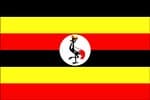Includes historical data for Uganda’s Gross Domestic Product growth, debt-to-GDP ratio and more, as well as information on trade, banking and financial sector leadership.
Economic Reforms Propel Growth
With a market-based economy, ample fertile soils, oil and gold resources, and a young English-speaking population, Uganda has vast economic potential. Over recent decades, its relatively diversified economy has seen significant growth, aiding poverty reduction efforts.
Yet, under President Yoweri Museveni, reelected for the ninth time in 2021 and in power since 1986, domestic political tensions, restrictions on democratic institutions and corruption persist. The government welcomes foreign investment but the business environment faces challenges of economic mismanagement, corruption, and failure to invest adequately in social and physical infrastructure. Lingering endemic poverty, security concerns in border areas, and weather and climate change-related vulnerabilities further hinder the country’s long-term socio-economic prospects.
Macroeconomy & Sovereign Data
| Type of Government | Presidential republic |
|---|---|
| Capital | Kampala |
| Sovereign Ratings |
S&P: B– Moody’s: B3 Fitch Ratings: B+ |
| Total Population | 46.9 million |
| Median Age | 16.5 |
| Adult Per Capita Income (PPP) | 5,810.35 |
| Total GDP (2023) | 56.3 billion |
Uganda GDP & Economic Overview
Most Recent Content
Uganda
Banking & Finance
Trade & Investment
| Total Exports | USD 7.2 billion (2023) |
|---|---|
| Leading Exports |
Gold Coffee Milk Fish And Fish Products Tobacco |
| Total Imports | USD 4.9 billion (2022) |
| Leading Imports |
Packaged Medicines Aircraft Delivery Trucks Cars Wheat |
| Source: | World Integrated Trade Solution |
Uganda Leading Companies
| Centenary Bank | Financials |
|---|---|
| Uganda Telecom | Telecommunication Services |
| Uganda National Oil Company | Integrated Oil & Gas |
| Uganda Breweries | Consumer Staples, Brewers |
| Tororo Cement | Materials, Building Products |
| Kakira Sugar | Consumer Staples, Food Products |
| Umeme | Utilities |
Major Trade Partners — Import
| China | 16% |
|---|---|
| India | 12% |
| Kenya | 9% |
| Tanzania | 9% |
| United Arab Emirates | 6% |
Source: World Integrated Trade Solution
Major Trade Partners — Export
| United Arab Emirates | 44% |
|---|---|
| Kenya | 11% |
| South Sudan | 9% |
| Democratic Republic of the Congo | 6% |
| Italy | 3% |
Source: World Integrated Trade Solution
Global Finance Rankings & Awards
Data Sources:
UN World Population Prospects
World Inequality Report
S&P Global Ratings
Moody’s
Fitch Ratings
IMF Direction of Trade Statistics (DOTS)
UN Conference on Trade and Development (UNCTAD)
CIA The World Factbook
World Bank’s World Integrated Trade Solution
Forbes Global 2000







